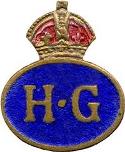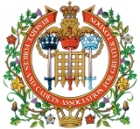
The Home Guard was formed in May 1940 in response to the expected invasion of the United Kingdom by German armed forces, in particular airborne troops.
Originally called the Local Defence Volunteers (LDV), the Home Secretary at the time, Anthony Eden, broadcast nationally on 14th May 1940 calling for volunteers for the new organisation to give their names in at their local police station. Within seven days, over 250,000 Volunteers had stepped forward.
As with the Volunteer Training Corps formed for Home Defence at the start of WW1, the War Office would not permit the LDV to use military ranks and the leadership element of the organisation automatically projected itself from veterans of previous conflicts, industrial management and natural leaders. A Land Defence Volunteer armband was worn in order to allow the volunteers to carry out their duties with some legal standing, but the issue of sufficient weaponry and uniforms was still some months away.
On 22nd July 1940 and at the insistence of the Prime Minister Winston Churchill, the LDV became the Home Guard.
The Role of the Home Guard
As with any home defence organisation, the Home Guard had an advantage over the enemy in that it was familiar with the towns, villages, industrial complexes and public services that it would be defending whereas the enemy forces would not.
Initially the plan was that this lightly armed force would simply guard key points such as public service utilities, transport links and centres of communication, all essential to the war effort of the United Kingdom. Should there be a full scale invasion, then the Home Guard would face the enemy in whatever form and take its chances with other combat formations in the defence of the United Kingdom.
In the event, the Home Guard had to adapt and take on new roles as the war progressed including anti-aircraft and searchlight operations, prisoner escorts and assistance to the civil defence organisations.
On the occasion of the fiftieth anniversary of the ending of WW2, some veteran Home Guardsmen now released from the strictures of the Official Secrets Act gave details of hitherto unknown training for covert activities by specially selected Home Guard personnel.
The Volunteer
Generally speaking, volunteers for the Home Guard would be aged between 17 and 65 and would be either medically downgraded for fulltime military service, employed in a reserve occupation or waiting to be called up for the regular services. The Home Guardsman would need to be of average fitness for his age. Within Greater London, his clothing and equipment would be supplied by any one of three Territorial Auxiliary and Air Force Associations depending on the location of his unit. The three administering associations were County of London, City of London and County of Middlesex.
Home Guard duties were fitted in around the individual civilian occupation. Personal weapons, clothing and equipment were kept at home or at certain times of high emergency kept nearby in the work place. In 1940, the Home Guardsman living within the London district area of control (now Greater London) would join any one of 135 Home Guard Battalions depending on his occupation (i.e. bus drivers and conductors would join one of the seven raised by London Passenger Transport Board).
These Battalions were organised in a similar way to standard infantry of which the smallest operational sub unit was the platoon, whereas Battalion and company headquarters were based in larger premises such as vacated TA Drill Halls. The platoon tended to train and be administered in smaller accommodation such as church halls and work canteens – in fact anywhere that afforded space for training and office facilities for unit administration.
Women were informally invited to join the Home Guard in December 1941. By that date the scope and reach of the Home Guard had expanded to include transport, artillery and specialist units and there was a need for an administration and logistical backup similar to that provided by ATS to the Regular Army.
In 1942, with the threat of invasion passed, the National Service Act allowed for compulsory enrolment where units were falling below strength. The organisation now came under the control of the Regular Army and was integrated into the Regimental system. As well as manning Anti-Aircraft guns and rockets, plus costal defence artillery, the Home Guard was increasingly seen as a preliminary training ground for young men waiting to be called for regular service.
Command Structure
London District was the Army Command Headquarters within the Greater London area. Once the War Office had assumed control of the Home Guard, the units raised within the Greater London area came under the responsibility of London District who created a Chain of Command structure that divided Greater London into 4 sub areas: North East, North West, South East and South West. Each sub area was further divided into zones of responsibility that broadly coincided with Metropolitan police divisions.
One or more Battalions were responsible for the security of the area covered by their zone. In addition, there were several public utility companies providing essential domestic supplies or transport networks that were allocated their own security Battalions.
‘Specialist' units of the Home Guard provided security for the London District military signals network as did smaller operational units such as the ‘Upper Thames Patrol'.
There were 135 Battalions under the control of London District; each was numbered according to the chronological order of numbering of Home Guard Battalions within the county that they were recruited. Therefore Home Guard Battalions from the Greater London area and under the control of London District are listed as follows:
Administration of Home Guard zones, groups and specialist units within Greater London by TA and AF Association
The County of London TA and AF Association, Duke of York's Headquarters, Chelsea, SW3
London County Council Group
Metropolitan Water Board
Central London Electricity
Metropolitan Electric Supply Company
County of London Electrical Supply Company
South Metropolitan Gas Company
Wandsworth Gas Company
Associated Operators (London District Battalion)
1st American Squadron
99th County of London (Taxi) Battalion
Fisher Renwick & Co Ltd ( 1st City of London Battalion)
Middlesex Company ‘Upper Thames Patrol'
HQ London District Signal Company
The City of London TA and AF association, Finsbury Barracks, City Road EC1
17th (City of London) (LNER) Battalion
General Post Office
Post Office London Telephone Communications Region
Post Office London Postal Region Group
Port of London Authority
Metropolitan Transport Supply Company Ltd (No. 2 City of London
Transport Battalion)
Middlesex TA and AF association, 20 Grosvenor Gardens SW1
Zone S and X
Zone V and T
Battalions located in London County, Middlesex County and the City of London
Battalions located in Counties under London District Command
51st to 57th
Included in Battalion titles were either the name of the town, area or public utility from where the Battalion was raised e.g. 3rd (Middlesex) Battalion, 55th (Sutton and Cheam) Battalion or 41st County of London (London Passenger Transport Board) Battalion.
Home Guard Battalion titles should not be confused with London Regiment TA units. Battalions were badged as per the county Regiment or the Territorial Army or the Territorial Army London Regiment. The Regimental cap badge issued to Home Guard units were manufactured in plastic as a war economy measure.
Casualties
During WW2, the Home Guard throughout the United Kingdom suffered 1,765 casualties on duty. 760 were fatalities, the majority killed by enemy action during the blitz on London. Several members of the London Home Guard Battalions added the George Medal and George Cross to an already impressive list of medals for bravery.
The Stand Down
The Home Guard was finally stood down in October 1944 with a parade to mark the occasion and the salute being taken by King George VI. Male members were entitled to a certificate of appreciation for their service signed by The King. If a Home Guardsman had served for more than three years he would be entitled to claim the defence medal, but it was not until 1945 that women who had helped as auxiliaries were recognised with their own certificate.
As the WW1 Armistice had been signed only 21 years before the Home Guard was formed, many of the Officers and men who served in its ranks were already experienced and some highly decorated. This helped greatly in the rapid progress from the enthusiastic but poorly equipped LDV to the efficient and professional reserve army that the Home Guard had become by 1944, when contrary to popular myth the average age within the Home Guard was under 30.
As a final accolade, the Home Guard provided a marching detachment in both the victory parade in 1946 and, almost 10 years after stand down, the Coronation procession of 1953.
In 1960, the TA and AF associations were still responsible for administering the Home Guard in a National Emergency.
